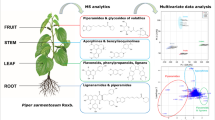Abstract
Schisandra chinensis (Turcz.) Baill. is a rich source of lignans with diverse biological activities. Quantitative analysis and chromatographic fingerprinting of the fruitlets of the plant by liquid chromatography (LC) were performed in order to characterize and evaluate the region-related variation. Using the optimized LC method, satisfactory linearity and repeatability were obtained for all the test standards. This method was subsequently applied for the identification and quantitation of six lignans in fruitlets of Schisandra chinensis by comparing the retention time with that of authentic standards available. Principal component analysis (PCA) was also employed to assess the similarity and dissimilarity of the fingerprint profiles from different origins encompassing eleven areas from China and two samples from Japan. The work suggested that the fruitlets of Schisandra chinensis from Japan exhibited great difference with those from China as evidenced by the clear separation in the PCA scores plot as well as quantitative analysis e.g., schisandrin and deoxyschisandrin are 5.50 μg mg−1 \( (\overline{X} ) \) and 0.90 μg mg−1 \( (\overline{X} ) \) in the materials from China and 3.40 μg mg−1 \( (\overline{X} ) \) and 1.90 μg mg−1 \( (\overline{X} ) \) in the materials from Japan, respectively. Such a reliable method potentially provides an effective and convenient method for quality control of herbal medicine from different regions.


Similar content being viewed by others
References
Mu Y, Zhang J, Zhang S, Zhou HH, Toma D, Ren S, Huang L, Yaramus M, Baum A, Venkataramanan R, Xie W (2006) J Pharmacol Exp Ther 316(3):1369–1377
Chen CC, Shen CC, Shih YZ, Pan TM (1994) J Nat Prod 57(8):1164–1165
Ikeya Y, Taguchi H, Yosioka I, Kobayashi H (1979) Chem Pharm Bull 27(6):1383–1394
Ikeya Y, Taguchi H, Yosioka I, Iitaka Y, Kobayashi H (1979) Chem Pharm Bull 27(6):1395–1401
Ikeya Y, Taguchi H, Mitsuhashi H, Takeda S, Kase Y, Aburada M (1988) Phytochemistry 27(2):569–574
Ikeya Y, Miki E, Okada M, Mitsuhashi H, Chai JG (1990) Chem Pharm Bull 38(5):1408–1411
Zhu M, Chen XS, Wang KX (2007) Chromatographia 66(1–2):125–128
Opletal L, Krenkova M, Havlickova P (2001) Ceska Slov Farm 50(4):173–180
Yamada S, Murawaki Y, Kawasaki H (1993) Biochem Pharmacol 46:1081–1085
Kvasnickova L, Glatz Z, Sterbova H, Kahle V, Slanina J, Musil P (2001) J Chromatogr A 916(1–2):265–271
Tong YY, Song WZ (1989) Zhongguo Zhong Yao Za Zhi 14(10):611–614
Wang K, Tong YY, Song WZ (1990) Yao Xue Xue Bao 25(1):49–53
Zhu M, Cao Y, Fan GR (2007) J Sep Sci 30(1):67–73
Avula B, Choi YW, Srinivas PV, Khan IA (2005) Chromatographia 61(9–10):515–518
Goebel HH, Ikeda K, Schulz F, Burck U, Kohlschutter A (1981) Acta Neuropathol (Berl) 55(3):247–249
Goebel HH, Warlo I, Klockgether T, Harzer K (1995) Am J Med Genet 57(2):187–190
Li F, Yuan B, Xiong Z, Lu X, Qin F, Chen H, Liu Z (2006) Biomed Chromatogr 20(6–7):634–641
Misumi K, Hirakawa A, Sakamoto H, Shimizu R (1994) J Vet Med Sci 56(6):1075–1080
Lindon JC, Holmes E, Nicholson JK (2007) Febs J 274:1140–1151
Acknowledgements
This work was supported by the Shanghai Leading Academic Discipline Project (grant no: T0301) and National Natural Science Foundation of China (grant no: 30672636). The fruits of S. chinensis were identified by Dr. Eiji Miki of the Tsumura Central Laboratories, Tsumura and Co., Japan. The reference standards were supplied by the Tsumura Central Laboratories, Tsumura and Co., Japan.
Author information
Authors and Affiliations
Corresponding author
Rights and permissions
About this article
Cite this article
Zhang, Y., Dan, M., Wu, J. et al. Study on the Chromatographic Fingerprinting of Schisandra chinensis (Turcz.) Baill. by LC Coupled with Principal Component Analysis. Chroma 68, 101–104 (2008). https://doi.org/10.1365/s10337-008-0653-z
Received:
Revised:
Accepted:
Published:
Issue Date:
DOI: https://doi.org/10.1365/s10337-008-0653-z




